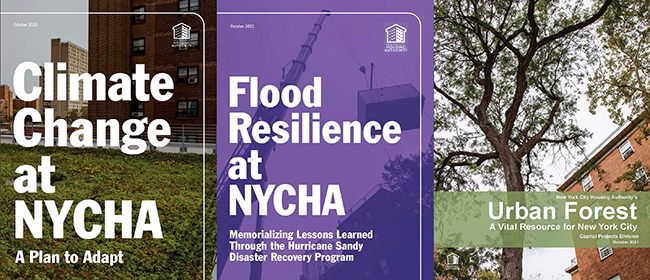NYCHA’s Climate Adaptation Plans for Extreme Weather
The strategic plans informed by NYCHA’s climate resiliency work on developments affected by Hurricane Sandy take a three-pronged approach to retrofitting buildings against rising sea levels, hotter temperatures, and heavier rainfalls expected in the coming decades.
On October 25, NYCHA announced the release of three major reports outlining the Authority’s approach to protecting its portfolio of 2,198 buildings against three weather trends expected to more significantly affect the New York City metropolitan region as a result of changing climate hazards. An expanded flood zone from rising sea levels, hotter annual temperatures, and heavier downpours – among other inclement conditions – are increasing the risk to maintaining public housing.
Climate Change at NYCHA; NYCHA’s Urban Forest; and Flood Resilience at NYCHA — distill the lessons learned and institutional knowledge gained from nine years of resilience work repairing and protecting 200 of the most severely damaged buildings affected by Hurricane Sandy in 2012. Over $2.4 billion in funding — mostly from the Federal Emergency Management Agency (FEMA) — has been invested to better protect NYCHA’s buildings, public grounds, and power equipment from the impacts of future storms.
“As we continue to make the necessary upgrades that will improve the quality of NYCHA housing for our residents, we must also remain focused on protecting our buildings against climate-induced vulnerabilities,” said NYCHA Chair & CEO Greg Russ. “Incorporating resiliency planning in our capital work will enable us to be better prepared for this new reality.”
“NYCHA is working proactively to prepare for extreme weather hazards by analyzing where and how a changing climate will affect NYCHA residents and properties, and by developing strategies to reduce resulting risks,” said NYCHA’s Executive Vice President of Capital Projects Steven Lovci. “We aren’t waiting to meet the massive challenges that will be created by global warming head-on.”
”NYCHA is setting the standard across the country’s real estate industry to proactively plan for climate change. I commend NYCHA’s leadership to prepare New York City’s public housing residents for a hotter and wetter future,“ said Jainey Bavishi, Director of the Mayor’s Office of Climate Resiliency. “The reports released today exemplify the City’s approach to climate resiliency by centering climate justice, considering the multiple threats posed by climate change, and focusing on people, buildings, and campuses to create multiple layers of resiliency.”
“Safe, affordable housing is essential for the health of all New Yorkers, especially as we face more extreme weather due to climate change,” said NYC Health Commissioner Dr. Dave A. Chokshi. “Structural racism is at the root of decades of disinvestment in public housing, making NYCHA home to more Black and Latinx New Yorkers than any other housing type. These plans will not only further climate justice, but also contribute to our City’s efforts to end racism as a public health crisis.”
Resiliency planning is central to the strategies outlined in the Climate Change at NYCHA Plan. If current projections hold, more than one-third of NYCHA buildings will be located within the city’s floodplain by 2100. To combat this challenge, the Authority will look to house vital mechanical, electrical, and plumbing equipment in raised annexes, and install additional backup generators to ensure that power at NYCHA campuses is protected.
The report outlines a two-pronged approach for addressing higher annual temperatures: increasing NYCHA’s tree canopy cover and other passive cooling strategies and expanding access to reliable indoor cooling systems. NYCHA is the second-largest owner of greenspace in New York City, which has shown a demonstrable effect on cooling campuses during the summer months. As such, a plan is underway to both increase the amount of tree plantings at campuses with less tree cover and elevate tree care throughout campuses. Inside apartments, the Authority is working toward expanding access to cooling. NYCHA has piloted a variety of technologies with the goal of integrating reliable cooling into planned retrofits of heating systems.
The arrival of Tropical Storm Ida this past August highlighted the challenges posed by heavier rainfall , with several NYCHA campuses in Queens and the Bronx experiencing significant impacts. By 2050, experts predict that intense rainstorms that would have occurred every 50 years will happen every five years. NYCHA’s strategy for adapting to heavier and more frequent rain is centered on shoring up the Authority’s existing stormwater management systems while investing in green infrastructure to better absorb heavy rainfall.
Common features of stormwater management systems include porous materials — which let rainwater penetrate through concrete, pavers, or other materials and seep into the ground rather than running off — and resilient plantings such as native grasses that do not need to be mowed and increase the amount of water that soils can absorb. The Authority is also in the process of developing several multi-functional infrastructure demonstration projects, such as a sunken basketball court at South Jamaica Houses and a sunken water square at Clinton Houses to offer the added benefit of increasing sub-surface water retention while serving as a public amenity.
In addition to preparing for additional weather hazards exacerbated by climate change, such as rising groundwater and extreme winds, the Climate Change at NYCHA report also highlights the concept of “social resilience,” which refers to the ability of a community to reasonably recover from inclement weather challenges. For example, research on social resilience has shown that strong community connections can actually reduce heat-related deaths, because those who know their neighbors and have safe, comfortable places to go are more likely to leave hot apartments during extreme heat or reach out to neighbors for help.
Key goals of NYCHA’s social resiliency planning include continuing to work with a Climate Action Network composed of residents who give input on NYCHA’s resilience and sustainability initiatives, as well as retrofitting community spaces to serve as resiliency hubs during a time of emergency.

